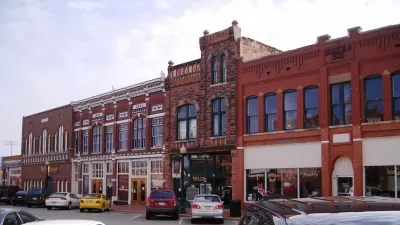Developers are frequently cast as a kind of monolithic bad guy in the politics of development, but developers are cut from different cloths, each with distinct interests and motivations.

Daniel Herriges shares a schema that can help people understand the world of real estate development—namely, that not all developers are alike.
There are three distinct varieties of developer, according to Herriges, each operating on a different business model. "They build different types of buildings, in different places. They use different sources of financing. Local rules and regulations affect these different groups very differently, and—importantly—their interests often do not align," writes Herriges.
So what are these three kinds of developers? Herriges lists residential developers types as follows: 1) big national homebuilders, like Lennar, Pulte, and D.R. Horton; 2) the "big urban box" developers that are smaller than the national builders but still likely to have a major influence over politics at the local and regional level; and then there are the 3) incremental infill developers. Herriges notes that there are also three types of commercial developers, but keeps the focus of this article on residential developers.
To further elucidate the differences between these three kinds of developers, Herriges digs into the business models of each type, identifying fundamental differences between each of them. But most helpfully, Herriges also devotes significant attention to the question of why these distinctions matter—the answer is immediately apparent in the lack of alignment in the interests of each of these three kinds of developers.
FULL STORY: There Are 3 Different Kinds of Developers

Study: Maui’s Plan to Convert Vacation Rentals to Long-Term Housing Could Cause Nearly $1 Billion Economic Loss
The plan would reduce visitor accommodation by 25,% resulting in 1,900 jobs lost.

North Texas Transit Leaders Tout Benefits of TOD for Growing Region
At a summit focused on transit-oriented development, policymakers discussed how North Texas’ expanded light rail system can serve as a tool for economic growth.

Alabama: Trump Terminates Settlements for Black Communities Harmed By Raw Sewage
Trump deemed the landmark civil rights agreement “illegal DEI and environmental justice policy.”

How Community Science Connects People, Parks, and Biodiversity
Community science engages people of all backgrounds in documenting local biodiversity, strengthening connections to nature, and contributing to global efforts like the City Nature Challenge to build a more inclusive and resilient future.

Alabama: Trump Terminates Settlements for Black Communities Harmed By Raw Sewage
Trump deemed the landmark civil rights agreement “illegal DEI and environmental justice policy.”

Dear Tesla Driver: “It’s not You, It’s Him.”
Amidst a booming bumper sticker industry, one writer offers solace to those asking, “Does this car make me look fascist?”
Urban Design for Planners 1: Software Tools
This six-course series explores essential urban design concepts using open source software and equips planners with the tools they need to participate fully in the urban design process.
Planning for Universal Design
Learn the tools for implementing Universal Design in planning regulations.
City of Santa Clarita
Ascent Environmental
Institute for Housing and Urban Development Studies (IHS)
City of Grandview
Harvard GSD Executive Education
Toledo-Lucas County Plan Commissions
Salt Lake City
NYU Wagner Graduate School of Public Service




























